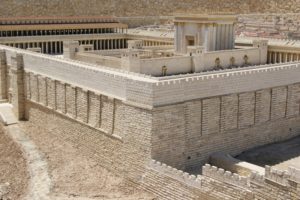The largest building on the Temple Mount in Jesus’ day wasn’t the Temple.
Herod’s Royal Stoa won that designation.
A stoa in classical Greek architecture is a covered portico or walkway. It was usually walled at the back, open at the entrance, and supported by columns.
During his reign, Herod built a large, three-story stoa and basilica spanning the whole length of the southern wall of the Temple Mount. It was supported by 162 massive Corinthian columns. Each column soared to 50 feet and spanned 16 feet in diameter.
Its open concept served multiple functions, such as hosting political meetings and commerce.
Beginning in AD 30, the Sanhedrin held its meetings in the Royal Stoa. In fact, it may have been the site of the money changers whose tables Jesus overturned (as recorded in Matthew 21:12-13; Mark 11:15-18; Luke 19:45-46; and John 2:13-16)
The Court of the Gentiles
A three-foot-high balustrade separated The Court of the Gentiles was separated from the temple area. A balustrade is a row of small, decorative columns topped with a rail, creating a beautiful and solid barricade.
Archaeologists have discovered stone signs etched in Greek and once posted at the balustrade on the Temple Mount, warning the ritually impure (both Jew and Gentile) not to proceed:
No foreigner may enter within the balustrade around the sanctuary and the enclosure. Whoever is caught, on himself shall he put blame for the death which will ensue.
The warning indicates Gentiles were at least allowed on the Temple Mount itself. It is unknown whether offenders of this ban were really executed by Jewish officials or left for God’s judgment.
Ancient reports paint a picture of non-Jews ascending onto the Temple Mount and bringing animals for sacrificial offerings. As with the ritually impure Jews, they could only stay within the outer court and give their offerings to the priests for sacrifice.
Who was Herod the Great?
The king who renovated the Second Temple and created the Royal Stoa was the progeny of intermarriage between Jews and Edomites. Herod identified himself as Jewish but didn’t follow Jewish rites. He was named governor of Galilee in 41 BC and ruled in the footsteps of his Hasmonean father before him.
When he supported Rome in opposition to the Hasmonean dynasty, however, Rome rewarded him the title King of the Jews and ordered him to conquer and rule Judea under its authority.
He accomplished this with a fervor earning him a reputation for both his benevolence and barbarism. After his conquest of Judea, he enlarged and renovated Jerusalem’s Second Temple in a bid to gain the favor of the Jews. Temple construction began in 19 BC and took 46 years to complete. It wasn’t truly finished, however, until the rule of procurator Albinus (AD 62-64), just seven years before its destruction at the hands of Rome. For a brief time, Herod’s Temple, as it was called, reportedly outshined even Solomon’s Temple.
Herod did not live to see his grand structure in its final glory.
This so-called “King of the Jews” built a splendid temple in his own name, slaughtered Jewish children in a vain bid to eradicate the competitor for his throne, and died an agonizing death in AD 4.
Researchers believe he died of kidney disease and Fournier’s gangrene in his groin. The cause may have been either an abscess, gonorrhea, or from scratching the intense itch he reportedly suffered. Maggots infested the infected area.
Herod’s body returned to the earth and his soul now awaits judgment. The Roman general Titus reduced his splendid temple to rubble in AD 70. His jealous bid for the title of King of the Jews never threatened the kingdom of God.
Jesus of Nazareth grew to manhood, conducted a three-year ministry, and surrendered His life to pay the debt owed by humanity. His body lay in a tomb for only three days. Shortly after His resurrection, He ascended to heaven, where He now sits at the right hand of the Father.
The pretender to the throne is dead. The real King of the Jews lives forever.
Temple Mount Photo ID 20310445 © Rkckwwjd | Dreamstime.com






















Leave a Reply